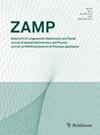具有两个松弛参数的MGT热弹性问题
IF 1.6
3区 数学
Q2 MATHEMATICS, APPLIED
Zeitschrift fur Angewandte Mathematik und Physik
Pub Date : 2023-09-15
DOI:10.1007/s00033-023-02080-z
引用次数: 0
摘要
摘要本文从解析和数值两方面考虑了一个热弹性问题。对位移和热位移采用两种不同松弛参数的MGT模型,得到由两个三阶时间偏微分方程组成的线性耦合系统。然后利用线性半群理论证明了该问题的存在唯一性。如果我们限制在一维情况下,假设本构参数的某些条件,就可以得到能量的指数衰减。然后,利用经典的有限元方法和隐式欧拉格式,我们引入了热力学问题变分公式的完全离散近似。给出了一个主要的先验误差估计结果,并由此得出在适当的附加正则性条件下线性收敛的结论。最后,我们给出了一些一维数值模拟来证明完全离散近似的收敛性,离散能量衰减的行为以及对耦合参数的依赖。本文章由计算机程序翻译,如有差异,请以英文原文为准。

A MGT thermoelastic problem with two relaxation parameters
Abstract In this paper, we consider, from both analytical and numerical viewpoints, a thermoelastic problem. The so-called MGT model, with two different relaxation parameters, is used for both the displacements and the thermal displacement, leading to a linear coupled system made by two third-order in time partial differential equations. Then, using the theory of linear semi-groups the existence and uniqueness to this problem is proved. If we restrict ourselves to the one-dimensional case, the exponential decay of the energy is obtained assuming some conditions on the constitutive parameters. Then, using the classical finite element method and the implicit Euler scheme, we introduce a fully discrete approximation of a variational formulation of the thermomechanical problem. A main a priori error estimates result is shown, from which we conclude the linear convergence under suitable additional regularity conditions. Finally, we present some one-dimensional numerical simulations to demonstrate the convergence of the fully discrete approximation, the behavior of the discrete energy decay and the dependence on a coupling parameter.
求助全文
通过发布文献求助,成功后即可免费获取论文全文。
去求助
来源期刊
CiteScore
2.90
自引率
10.00%
发文量
216
审稿时长
6-12 weeks
期刊介绍:
The Journal of Applied Mathematics and Physics (ZAMP) publishes papers of high scientific quality in Fluid Mechanics, Mechanics of Solids and Differential Equations/Applied Mathematics. A paper will be considered for publication if at least one of the following conditions is fulfilled:
The paper includes results or discussions which can be considered original and highly interesting.
The paper presents a new method.
The author reviews a problem or a class of problems with such profound insight that further research is encouraged.
The readers of ZAMP will find not only articles in their own special field but also original work in neighbouring domains. This will lead to an exchange of ideas; concepts and methods which have proven to be successful in one field may well be useful to other areas. ZAMP attempts to publish articles reasonably quickly. Longer papers are published in the section "Original Papers", shorter ones may appear under "Brief Reports" where publication is particularly rapid. The journal includes a "Book Review" section and provides information on activities (such as upcoming symposia, meetings or special courses) which are of interest to its readers.

 求助内容:
求助内容: 应助结果提醒方式:
应助结果提醒方式:


